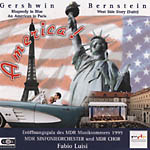Listening to this recording brought to mind the old Saturday Night Live skit about the two Czechoslovakian brothers who claimed, in their best attempt at sounding American, that they were “two wild and crazy guys.” The Middle German Symphony Orchestra certainly is earnest in trying to play this very American music with authenticity, but to quote the Duke Ellington song, “it ain’t got that swing.” The opening solo of Rhapsody in Blue is totally devoid of sleaze, an essential ingredient that is missing throughout the performance, no matter how enthusiastic the players. Instead, pianist Nelson Goerner thrills us with a virtuoso interpretation in the style of Rachmaninov. An American in Paris sounds like a very nice piece of French music in this performance, and maybe this is what Gershwin intended. But he definitely did not intend the honky-tonk trumpet solo near the end to be as note perfect, rhythmically exact, and jazz-less as this. Perhaps this is the sort of music where nationality really does matter, where some American influence–from conductor or orchestra–would have made the difference. In fact, one of the best live performances ever of An American in Paris was conducted by the very Russian Gennady Rozhdestvensky–but his orchestra was the New York Philharmonic (who recorded it masterfully with Leonard Bernstein and Michael Tilson-Thomas on Sony Classical), and they “own” this piece (sort of like the Vienna Philharmonic “owns” Bruckner’s Eighth).
Conductor Fabio Luisi is more on target in the symphonic sections of the West Side Story suite. Charles Castronovo’s Tony sounds like an American (if from Westport, Connecticut, rather than Manhattan) but when it comes to Maria it’s clear that English is not Nura Kaminiczny’s first language, and apparently not anybody else’s involved in this production–her mix-up of the text in “Tonight” went totally unnoticed. Strangest of all is the Jets/Sharks chorus in the “Tonight” quintet, which sounds like an episode of the Twilight Zone in which the Tannhäuser chorus is mysteriously transported to 1950s New York City. Despite of all of this, you can’t help but smile at the chutzpah and sincerity of the performers. And who knows, maybe American orchestras occasionally sound like this to Europeans when playing Ravel or Rautavaara. Oh yeah, the sound is fabulous.
































